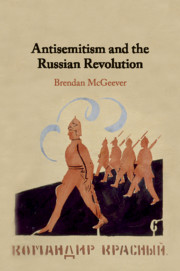Book contents
- Antisemitism and the Russian Revolution
- Antisemitism and the Russian Revolution
- Copyright page
- Contents
- Figures
- Acknowledgements
- A Note on Translation
- Terms and Abbreviations
- Introduction
- 1 1917: Antisemitism in the Moment of Revolution
- 2 ‘Red Pogroms’: Spring 1918
- 3 The Soviet Response to Antisemitism, 1918
- 4 Antisemitism and Revolutionary Politics: the Red Army in Ukraine, 1919
- 5 The Soviet Response to Antisemitism in Ukraine, February–May 1919
- 6 Jewish Communists and the Soviet Response to Antisemitism, May–December 1919
- 7 Reinscribing Antisemitism?
- Epilogue: In the Shadow of Pogroms
- Conclusions: Anti-Racist Praxis in the Russian Revolution
- Bibliography
- Index
3 - The Soviet Response to Antisemitism, 1918
Published online by Cambridge University Press: 16 September 2019
- Antisemitism and the Russian Revolution
- Antisemitism and the Russian Revolution
- Copyright page
- Contents
- Figures
- Acknowledgements
- A Note on Translation
- Terms and Abbreviations
- Introduction
- 1 1917: Antisemitism in the Moment of Revolution
- 2 ‘Red Pogroms’: Spring 1918
- 3 The Soviet Response to Antisemitism, 1918
- 4 Antisemitism and Revolutionary Politics: the Red Army in Ukraine, 1919
- 5 The Soviet Response to Antisemitism in Ukraine, February–May 1919
- 6 Jewish Communists and the Soviet Response to Antisemitism, May–December 1919
- 7 Reinscribing Antisemitism?
- Epilogue: In the Shadow of Pogroms
- Conclusions: Anti-Racist Praxis in the Russian Revolution
- Bibliography
- Index
Summary
The leadership of the broader Russian socialist movement made its position on antisemitism clear in the very moment of revolution itself. On 26 October 1917, as power passed into the hands of the Bolsheviks, the Second All Russian Congress of Soviets passed a resolution against pogroms.1 However, in the first nine months of Soviet power, the Bolshevik leadership did not broach the question of antisemitism even once. By late July 1918, no response had been made to the devastating Red pogroms in Chernihiv during the spring of that year. Eventually, on 26 July 1918, the Soviet government issued a decree on anti-Jewish violence. Traditionally, historians begin their discussions of the Bolshevik response to antisemitism after 1917 by citing this important document.2 However, the decree marked not the beginning but the culmination of the first phase of the Soviet response to antisemitism. Between April and July 1918, a small group of Jewish socialists were engaged in an intensive phase of anti-racist praxis within the lower echelons of the Soviet state apparatus. Until now, this chapter in the history of the Russian Revolution has been almost entirely overlooked.3
- Type
- Chapter
- Information
- Antisemitism and the Russian Revolution , pp. 53 - 87Publisher: Cambridge University PressPrint publication year: 2019



